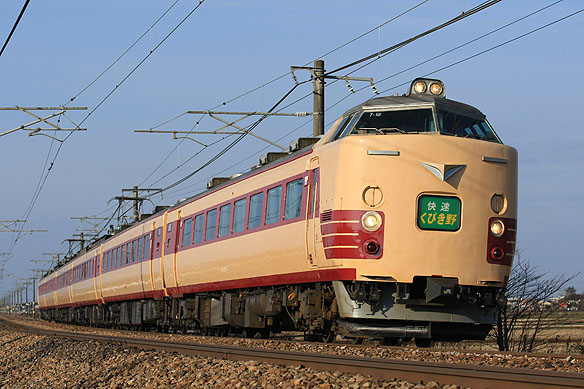Background and overview
Japanese National Railways (JNR) was proceeding with the plan to develop new intercity AC electric multiple unit (EMU) train for Hokkaido region. However, mass production would be delayed due to the discovery of the toxicity of PCBs used in the traction transformer. Therefore, JNR improved 485-300 series with heavy protection against snow to deliver for the intercity trains in Hokkaido and classified them 485-1500 series. 4 six-car sets consisting of 4 powered vehicles and 2n trailer vehicles were delivered in 1974.
Car body
They have 2946mm wide body. Their body design incorporates lightweight shaped steel and pressed forming beam to realize a lightweight body, employing weatherproof high tension steel sheet for the skin and the roof. Their end vehicles feature no gangwayed, and the body length is 250mm stretched to realize larger driver's cab. Their end vehicles feature raised driver's cab with plane glass windscreens. A roller binding built-in classification headboard and an inverted triangle gunmetal intercity express emblem are fitted at the front of end vehicles. A headlight employing the sealed beam light bulb and a taillight are longitudinally fitted each side of the classification headboard. Two additional headlights employing the sealed beam light bulb are also fitted on the roof of the cab to ensure visibility during snowfall. "JNR" logo made of stainless steel is applied to each side of the end section. They are equipped with a 700mm wide single-leaf automatic sliding stepped doors, and wide fixed double-glazing windows aligned two standard class seating bays. Heat absorbent glass is employed for all windows. Their door operating equipment, TK100B, is fitted on the door header of the sliding door. A destination rollsign is fitted on each side of the body. Class moha484-1500 vehicles are equipped with an air conditioner, AU71A, rated at 28,000 kcal/h and forced draught ventilators on the roof, the others 5 AU13EN rated at 5500kcal/h and forced ventilators. Their livery is cream with red wide band around side windows and red narrow skirting.
Bogies
The 485-1500 series are equipped with DT32G bogies on the powered vehicles and TR69G bogies on the trailers, featuring diaphragm air springs for the secondary suspension, the top of which is slanted in lateral direction, and pedestal type journal supporting system. Their secondary airbag suspension is not mounted to their body directly but mounted in the bogie unit. The parallel cardan drive with hollow shaft is applied for the power transmission device. The gear ratio is 3.50. Their brake rigging is a double tread brake.
Traction unit and ancillary equipments
Eight series-wound brushed DC traction motors, MT54D, with a power output
of 120kW are controlled by the armature-resistance traction control system,
CS15F, fitted to class moha485-1500 powered intermediate vehicles. CS15F
features holding breaking and free selectable speed control. The traction
resistor is MR127 which can be work even while the electric blower is stopped.
Class moha484-1500 powered intermediate vehicles are equipped with a traction
transformer employing silicone oil for electric insulation, TM20, and a
traction rectifier, RS40A, under the floor. They are also equipped with
two current pickups, PS16H, connected with the cable bus, and an air-blast
circuit breaker, CB103A, on the roof. Class kuha481-1500 end vehicles are
equipped with a motor generator, MH129-DM88, with a power output of 210kVA
under the floor. Class kuha481-1500 vehicles are equipped with an air compressor,
MH113B-C2000M under the co-driver's position, and an overhead line voltage
detector on the roof of the cab. They adopt electromagnetic straight air
brake with the rheostatic brake with pressure intensifying braking over
110km/h to shorten braking distance.
Accommodation
They have 2+2 abreast reclining seating, R51AN, with 910mm seating pitch. All vehicles adopt sliding curtains on side windows. They are equipped with a Japanese style toilet and a washroom toward the doorway. All toilets employ a chemical holding tank. Class moha484-1500 vehicles are also equipped with conductor's rooms beside the doorway.
Modification
485-1500 series displaced with 781 series EMU received some modifications in having standard bogies, DT32E on the powered and TR69H on the trailer, and the standard traction resistor, MR52D.
Operations
485-1500 series were delivered to Aomori depot and entered "Hakucho" services so on in 1974. Then they were reallocated to Sapporo depot to enter "Ishikari" intercity services in 1975. New generation intercity AC electric multiple unit, 781 series were delivered to Sapporo depot and entered revenue services along with 485-1500 series. Eventually, they had been completely withdrawn by the replacement with 781 series, were reallocated to Aomori depot again.
After that, they had worked along with 485-1000 series. Some vehicles were relocated to Mukomachi and Kaminuttari depots after 1985. Then, they were used on "Hokuesu" intercity services and "Kumikino" rapid services. Finally, they had been completely scrapped in 2013. |
|

